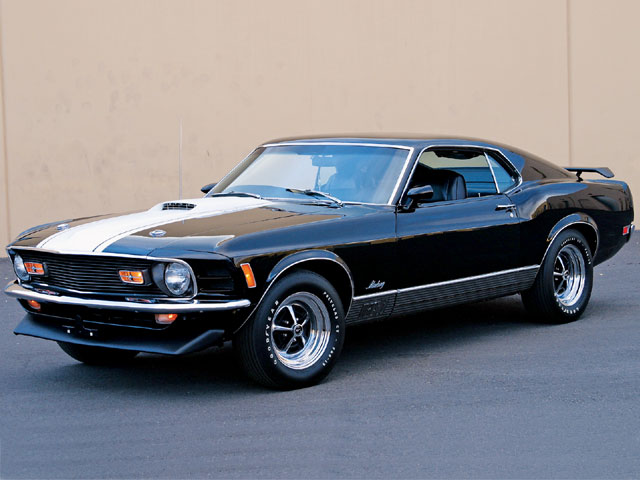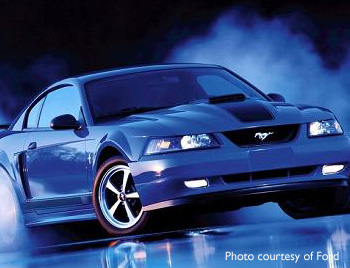Ford Mustang
The Pure American Muscle Car
For a car enthusiast, knowing the history of the Ford Mustang is as basic as knowing the laws of thermodynamics are to a physicist, knowing Hebrew is to a rabbi or knowing when the bacon is done to a cook at Denny's. The Mustang is a pillar of American automotive lore, and the car that brought sporting dash and styling at a price almost anyone could afford.
The Mustang has never been an exotic car. Even the rarest, most powerful Mustangs ever built (such as the '69 Boss 429) were assembled with haphazard care by a UAW workforce facing a quick-moving, continuous production line with parts that were shared in common with six-cylinder Falcons, four-door Fairlanes and stripped Galaxies. Handcrafting and taking the time to do something extra special has never been part of Mustang production.
But that hasn't kept the Mustang from capturing the hearts of drivers for nearly 40 years. As ordinary a car as the Mustang has always been, it has always been extraordinarily attractive.
The 1st Generation of Mustang (1964-1973)

(Source: http://autos.yahoo.com/blogs/motoramic/first-ford-mustang-owner-still-keys-49-years-123831938.html)
The first model Mustang, the early 65 was available as a coupe or convertible, and featured a base 170-cubic inch six-cylinder engine with a three-speed floor shift transmission. An optional 260-cubic inch V-8 engine was available, in addition to a four-speed manual transmission or a three-speed automatic “Cruise-O-Matic” transmission. The Falcon platform Mustang featured full wheel covers, bucket seats, carpeting, and a padded dash; all for a base retail price of $2,320. According to Ford, 22,000 orders were taken the day of its debut. This came as quite a surprise to Ford executives who had predicted annual sales of about 100,000 units. Within its first 12 months, Ford would sell close to 417,000 Mustangs.
The 2nd Generation Mustang (1974-1978)
(Source: http://www.askipedia.com/category/travel/)
For almost a decade, consumers had come to know the Ford Mustang as a power performance machine, with performance increases delivered on an almost yearly basis. In 1974, Ford took a different approach. Instead of increasing the engine size, they downsized it. A completely redesigned Mustang II was launched, available in either a 2.3L inline four cylinder engine or a 2.8L V-6. Neither engine was extremely powerful, outputting 88 hp and 105 hp respectively.
The 3rd Generation Mustang (1979-1993)

(Source: http://www.askipedia.com/category/travel/)
The third generation mustang had two different body styles. From 1979 to 1986 the car had a triangle shaped front clip and four headlights, known by enthusiasts as "4 Eyes." Then in the 1987 to 1993 model years, the front clip had a more round shaping known as the "aero" style. Also in 1986, engines featured EFI (electronic fuel injection) instead of carburetors. Other changes for the 1986 models included an upgraded 8.8-inch (224 mm) rear end with four shock absorbents.
The third generation mustang had two different body styles. From 1979 to 1986 the car had a triangle shaped front clip and four headlights, known by enthusiasts as "4 Eyes." Then in the 1987 to 1993 model years, the front clip had a more round shaping known as the "aero" style. Also in 1986, engines featured EFI (electronic fuel injection) instead of carburetors. Other changes for the 1986 models included an upgraded 8.8-inch (224 mm) rear end with four shock absorbents.
The 4th Generation Mustang (1994-2004)

(Source: http://www.amcarguide.com/muscle-cars/ford-mustang-1994-2004-4th-generation/)
For 1999, the Mustang received Ford's New Edge styling theme with sharper contours, larger wheel arches, and creases in its bodywork, but its basic proportions, interior design, and chassis remained the same as the previous model. The Mustang's power-trains were carried over for 1999, but benefited from new improvements. The standard 3.8 L V6 had a new split-port induction system, and was rated at 190 bhp (140 kW) 1999–2004, In 2001 the bhp was increased to 193. while the Mustang GT's 4.6 L V8 saw an increase in output to 260 bhp (190 kW) (1999–2004), due to a new head design and other enhancements. There were also three alternate models offered in this generation: the 2001 Bullitt, the 2003 and 2004 Mach 1, as well as the 320 bhp (240 kW) 1999 and 2001, and 390 bhp (290 kW) 2003 and 2004 Cobra.
For 1999, the Mustang received Ford's New Edge styling theme with sharper contours, larger wheel arches, and creases in its bodywork, but its basic proportions, interior design, and chassis remained the same as the previous model. The Mustang's power-trains were carried over for 1999, but benefited from new improvements. The standard 3.8 L V6 had a new split-port induction system, and was rated at 190 bhp (140 kW) 1999–2004, In 2001 the bhp was increased to 193. while the Mustang GT's 4.6 L V8 saw an increase in output to 260 bhp (190 kW) (1999–2004), due to a new head design and other enhancements. There were also three alternate models offered in this generation: the 2001 Bullitt, the 2003 and 2004 Mach 1, as well as the 320 bhp (240 kW) 1999 and 2001, and 390 bhp (290 kW) 2003 and 2004 Cobra.
The 5th Generation Mustang (2005-Present)

(Source: http://hooniverse.com/2013/07/05/the-news-for-july-5th-2013/)
For the 2005 to 2010 production years, the base model was powered by a 210 hp (157 kW; 213 PS) cast-iron block 4.0 L SOHC V6, while the GT used an aluminum block 4.6 L SOHC 3-valve Modular V8 with variable camshaft timing (VCT) that produced 300 hp (224 kW; 304 PS). Base models had a Tremec 3650 5-speed manual transmission with Ford's 5R55S 5-speed automatic being optional. Automatic GTs also featured this, but manual GTs had the Tremec TR-3650 5-speed.The 2010 model year Mustang was released in the spring of 2009 with a redesigned exterior and a reduced drag coefficient of 4% on base models and 7% on GT models. The engine for base Mustangs remained unchanged, while GTs 4.6 L V8was revised resulting in 315 hp (235 kW; 319 PS) at 6000 rpm and 325 lb·ft (441 N·m) of torque at 4255 rpm. Other mechanical features included new spring rates and dampers, traction and stability control system standard on all models, and new wheel sizes.
For the 2005 to 2010 production years, the base model was powered by a 210 hp (157 kW; 213 PS) cast-iron block 4.0 L SOHC V6, while the GT used an aluminum block 4.6 L SOHC 3-valve Modular V8 with variable camshaft timing (VCT) that produced 300 hp (224 kW; 304 PS). Base models had a Tremec 3650 5-speed manual transmission with Ford's 5R55S 5-speed automatic being optional. Automatic GTs also featured this, but manual GTs had the Tremec TR-3650 5-speed.The 2010 model year Mustang was released in the spring of 2009 with a redesigned exterior and a reduced drag coefficient of 4% on base models and 7% on GT models. The engine for base Mustangs remained unchanged, while GTs 4.6 L V8was revised resulting in 315 hp (235 kW; 319 PS) at 6000 rpm and 325 lb·ft (441 N·m) of torque at 4255 rpm. Other mechanical features included new spring rates and dampers, traction and stability control system standard on all models, and new wheel sizes.
Other Performance Edition of Mustang
Ford Mustang Boss 302

The Legend Is Back on the Streets
Born in '69. A 40-plus-year legacy on the track. Now, a road-racing legend has returned. Available in street and racing versions, today’s Boss 302 looks every bit as lean and mean as its predecessor. It’s also backed up with a 444-hp* beast under the hood.
2013 Mustang Boss 302 In Action
(Source: http://www.youtube.com/watch?v=4i4tAph0ocs)
(Source: http://www.youtube.com/watch?v=4i4tAph0ocs)
Ford Mustang Shelby GT500
The Shelby Mustang is a higher performance variant of the Ford Mustang which was built by Shelby American from 1965 through 1967, and Shelby Automotive from 1968 through 1970. Following the introduction of the fifth generation Ford Mustang, the Shelby nameplate was revived in 2007 for new high performance versions of the Mustang.
This is the most extreme powerful Mustang in Ford production.

(Source: http://planetcarz.blogspot.com.au/2012/10/ford-gt-mustang-wallpaper.html)
 (Source: http://planetcarz.blogspot.com.au/2012/10/ford-gt-mustang-wallpaper.html)
(Source: http://planetcarz.blogspot.com.au/2012/10/ford-gt-mustang-wallpaper.html)
(Source: http://planetcarz.blogspot.com.au/2012/10/ford-gt-mustang-wallpaper.html)
Here is my friend's Mustang Shelby GT500
Do you like it?

(Source: http://planetcarz.blogspot.com.au/2012/10/ford-gt-mustang-wallpaper.html)
 (Source: http://planetcarz.blogspot.com.au/2012/10/ford-gt-mustang-wallpaper.html)
(Source: http://planetcarz.blogspot.com.au/2012/10/ford-gt-mustang-wallpaper.html)
(Source: http://planetcarz.blogspot.com.au/2012/10/ford-gt-mustang-wallpaper.html)
Let's walk around and check out the Most Powerful Mustang
(Source: http://www.youtube.com/watch?v=Nf4CPpVgiHY)
(Source: http://www.youtube.com/watch?v=Nf4CPpVgiHY)
Here is my friend's Mustang Shelby GT500
Do you like it?






No comments:
Post a Comment